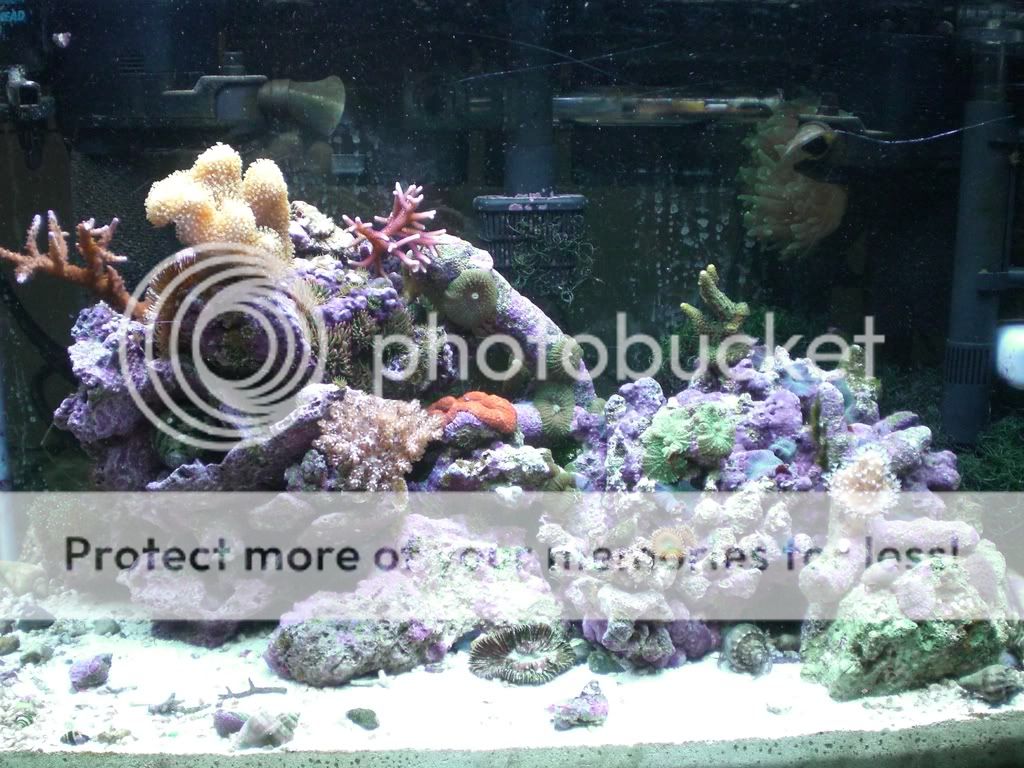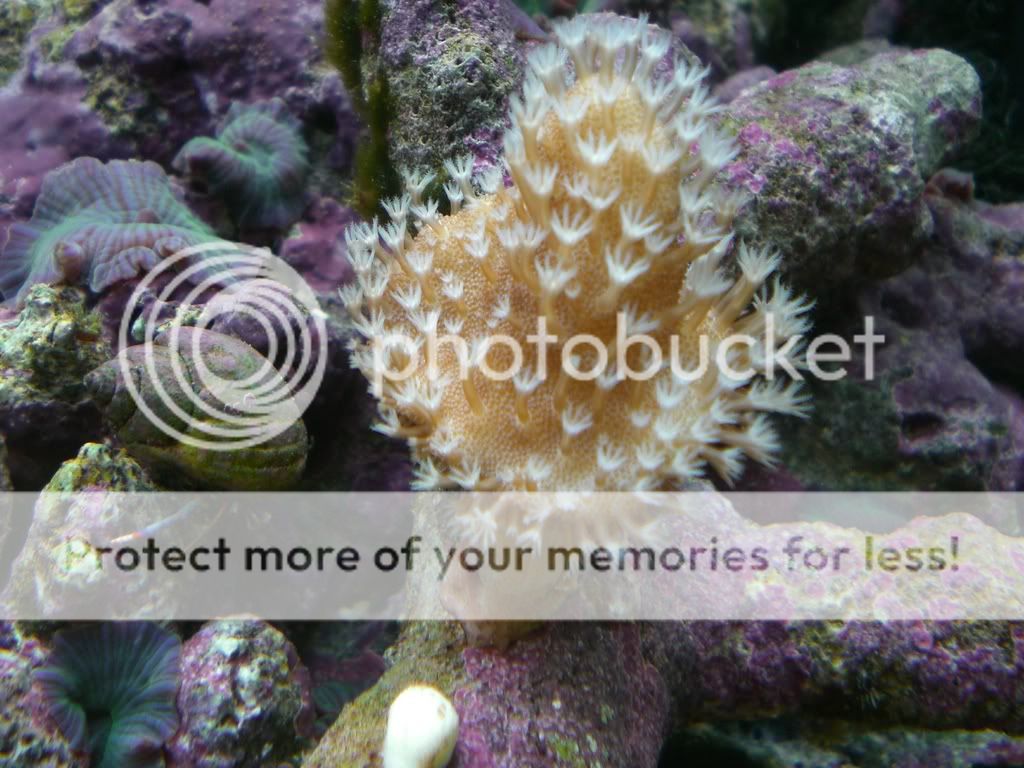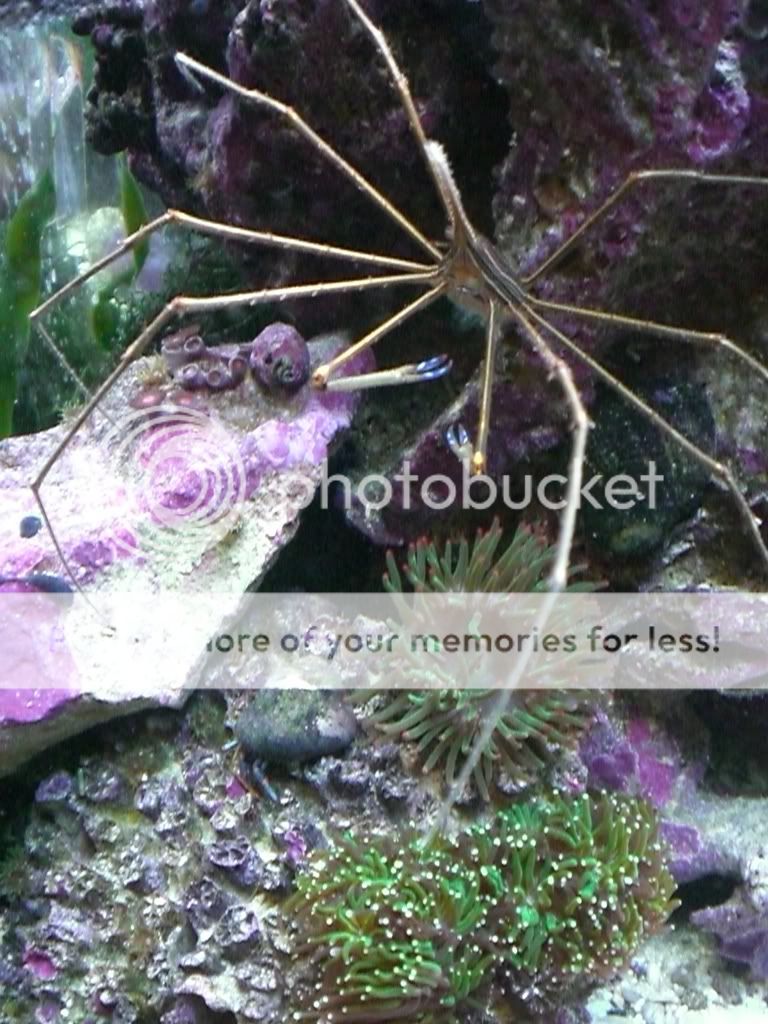mouserusker
New member
I'm going to repost this as a new thread, since it's a long story, and I've got lots to talk/ask about.
Hello, everyone. I have a bit of a long story, but I think it's unique, so here we go.
My cousin has had saltwater reef tanks for about five years, and I lived vicariously through his tanks. I did research for/with him, we talked about his tank and filters and corals and fish and inverts. I used any excuse to go to his house to stare into his big reef tank (I think it was about 180 gallons). I was, in my humble opinion, a very experienced, tankless saltwater newbie. Recently, the large reef tanks have been downgraded to a single 20 gallon tall (which is just packed full of life) in anticipation of some home renovations.
I had/have several freshwater tanks, mostly centering around a medium-sized snapping turtle that I raised from a hatchling. I couldn't find any room in my budget for the turtle's ever-growing needs as well as the up-front equipment costs for a saltwater tank.
On the morning of New Year's Day, I was sitting here at my computer, just like any other day. My cousin called me and told me that he and his family had just returned from their out-of-town New Year's Eve festivities to find that their house had burned down! It was a tragic accident (if anyone keeps any animals with heat lamps: beware playful, unattended kittens and nearby flammable blankets), and the home was a total loss. Ryan's family was all okay, as were all of the dogs. Two cats, two chameleons, and a baby tortoise were the only lives lost. I went over there (it's only a mile or two from my house), and we just stood in shock, speechless. I noticed the saltwater tank sitting there, cold and dark and covered in ashes. but still holding water. I figured that the least I could do was offer to take the tank and plug it in and save what I could.
And so it began. The water was around 50 degrees F, and all filtration and water motion had been offline for almost 7 hours. The tank was open to the elements, since a good portion of the house had burned down. ("The elements" here in northern Michigan were about -5 degrees F that day.) I had no firsthand experience, and I had been given a fully-cycled, mature, very heavily stocked, extremely distressed tank. I had no supplies, no LFS (nearest one is a little over an hour away), a tight budget, and literally a small handful of synthetic sea salt. I didn't even have a hydrometer! (When I got one, I found the salinity to be in the range of 20 to 23 ppt!)
I did what I could, figuring that even if I saved only the live rock it would be worth it. I only had 2 five-gallon buckets and a 3 gallon bucket, so I half filled them all with whatever rocks I grabbed first, and then siphoned water from the tank to cover the rocks. I didn't want to fill the buckets, since I had no lids and I had some bumpy roads between the tank and my home. Every drop of that saltwater was precious, since I had only a small ziploc baggy of sea-salt. That's right. No label, no directions, nuthin. Anyway, having drained barely half of the water, I saw little option but to put the half-full tank in the back of my SUV and try to drive REALLY carefully.
I got the tank home, put everything back in it (including that filthy, cloudy, cold saltwater) and plugged in the heaters, lights and one small, lonely powerhead. It turns out that the tank was in a rather cool location before the fire, and so was equipped with 3 heaters set to 'always on'. I realized this when the water temp soon got to 84 or 85. I'm glad I caught that one. Who knows how warm those heaters would have gotten. Then I waited.
So, it's been six or seven weeks, and the tank underwent a major makeover. You see, I didn't wait very patiently. There was an incredible rate of survival, in my opinion, and I soon felt the tank needed some minor, basic necessities. A couple of hours/hundred dollars later and I had a big box of goodies on it's way via the Drs. Foster and Smith website. Currently the set-up includes 65W 10000K power compact fluorescent, 65W Dual Actinic 420/460 nm power compact fluorescent (the lights are one double-bulb unit), Aqua-Tech 30-60 power filter, Rapids Mini-canister filter with surface-skimmer intake upgrade, Aquarium Systems Natural Wave Timer power strip running two Power-Sweep 216 powerheads and one small generic powerhead. My current readings are (approximately) SG: 1.0235, Temp: 77-80 degrees F, pH: 8.0, KH 8.5, Calcium: 380 ppm, Ammonia: 0 ppm, Nitrite <0.3, Iodine: .025 mg/L. These are the only things I can test for. I hope to get a Nitrate test kit soon.
So far, this is the species list I've come up with that I have identified living in my little box of salty heaven:
Shrimp
Peppermint Shrimp (Lysmata wurdemanni)
Crabs
Arrow Crab (Stenorhynchus seticornis)
Blue-Leg Hermit Crab (Clibanarius tricolor)
Electric Blue Hermit Crab (Calcinus elegans)
Electric Orange Hermit Crab (Calcinus sp.)
Scarlet Reef Hermit Crab (Paguristes cadenati)
Emerald Mithrax Crab (Mithrax sculptus)
Snails
Nassarius Snail (Nassarius distortus)
Bumble Bee Snail (Engina mendicaria)
Turbo Snail (Turbo fluctuosa)
Red Conch Snail (?)
Nerite Snail (Nerite sp.)
Corals
Toadstool Mushroom Leather Coral (Sarcophyton sp.)
Cabbage Leather Coral (Sinularia dura)
Kenya Tree Coral (Capnella imbricata)
Velvet Finger Coral (Montipora digitata)
Green Acropora Coral (Acropora sp.)
Birds Nest Coral (Seriatopora hystrix)
Green and Brown Polyp Coral (Zoanthus sp.)
Green Brain Coral (Trachyphyllia geoffroyi)
Orange Open Brain Coral (Lobophyllia hemprichii)
Anemones
Bubble-tip Anemone (Entacmaea quadricolor)
Green Fluorescent Mushroom (Actinodiscus sp.)
Green/Purple Striped Mushroom (Actinodiscus sp.)
Green Hairy Mushroom (Rhodactis indosinensis)
Pink-tipped Green Anemone (?)
Purple and Green Anemone (?)
Echinoderms
Asterina Star (Asterina sp.)
Brittle Sea Star (Ophiothrix sp.)
Algae
Green Spaghetti Algae (Chaetomorpha sp.)
Purple Coralline Algae (Family: Corallinaceae)
Annelids
Bristle Worm (Polychaete sp.)
‘Pods
Amphipods (Order: Amphipoda)
Amphipods (Gammarus sp.)
Copepods (Tisbe sp.)
Copepods (Acartia sp.)
Fish
Molly (Poecilia sp.)
(NOTE: The above list is amateurish, at best. Any corrections, updates, or outright insults would be greatly appreciated)
Of these, I added the arrow and mithrax crabs, the peppermint shrimp, the bubble-tip anemone, and the SPS corals (acropora, montipora, and seriatopora) Everything else survived several hours of intense abuse. Imagine taking your tank and turning off all the power to it, then using it as an ashtray, then putting it in a large freezer for several hours. After that, dump it into a bucket, shake it up, and dump it back in the tank, and finally drop the salinity by about 30% while quickly (and accidentally) heating the tank to near 90 degrees.
Anyway, my plans are to sell all of my freshwater tanks except for the 55 gallon, and turn the 55 into a reef tank with a 20 gallon sump. (yeah, I'm hooked). I hope to move everything from my current 20 tall into the 55 starting this summer (starting with more rock and cycling and all that happy crappy). As for stocking, I am especially mesmerized by the various symbiotic reef creature. I hope to soon get a couple of clowns to go with my anemone, and I really want a goby/shrimp combo as soon as space and funds allow it.
So, that's the full, unabridged story. Thanks for reading. I've been browsing this website as an unregistered guest since I first got the saltwater aquarium, and I've already learned so much. Thank you all for the wealth of knowledge.
My new reef tank:

Can anyone ID this coral for me?

My arrow crab is awesome! He's getting huge from all the bristle worms he eats. Also, I'm having a hard time figuring out what those two anemone-looking things at the bottom are. The pink-tipped green thing is (in my admittedly limited experience) clearly an anemone. The purple and green one with white tips appears to have a hard skeleton that looks like the rest of the "rock" they are attached to. Perhaps it used to be a lot bigger? If it has a hard skeleton, it must mot be an anemone, right?

Hello, everyone. I have a bit of a long story, but I think it's unique, so here we go.
My cousin has had saltwater reef tanks for about five years, and I lived vicariously through his tanks. I did research for/with him, we talked about his tank and filters and corals and fish and inverts. I used any excuse to go to his house to stare into his big reef tank (I think it was about 180 gallons). I was, in my humble opinion, a very experienced, tankless saltwater newbie. Recently, the large reef tanks have been downgraded to a single 20 gallon tall (which is just packed full of life) in anticipation of some home renovations.
I had/have several freshwater tanks, mostly centering around a medium-sized snapping turtle that I raised from a hatchling. I couldn't find any room in my budget for the turtle's ever-growing needs as well as the up-front equipment costs for a saltwater tank.
On the morning of New Year's Day, I was sitting here at my computer, just like any other day. My cousin called me and told me that he and his family had just returned from their out-of-town New Year's Eve festivities to find that their house had burned down! It was a tragic accident (if anyone keeps any animals with heat lamps: beware playful, unattended kittens and nearby flammable blankets), and the home was a total loss. Ryan's family was all okay, as were all of the dogs. Two cats, two chameleons, and a baby tortoise were the only lives lost. I went over there (it's only a mile or two from my house), and we just stood in shock, speechless. I noticed the saltwater tank sitting there, cold and dark and covered in ashes. but still holding water. I figured that the least I could do was offer to take the tank and plug it in and save what I could.
And so it began. The water was around 50 degrees F, and all filtration and water motion had been offline for almost 7 hours. The tank was open to the elements, since a good portion of the house had burned down. ("The elements" here in northern Michigan were about -5 degrees F that day.) I had no firsthand experience, and I had been given a fully-cycled, mature, very heavily stocked, extremely distressed tank. I had no supplies, no LFS (nearest one is a little over an hour away), a tight budget, and literally a small handful of synthetic sea salt. I didn't even have a hydrometer! (When I got one, I found the salinity to be in the range of 20 to 23 ppt!)
I did what I could, figuring that even if I saved only the live rock it would be worth it. I only had 2 five-gallon buckets and a 3 gallon bucket, so I half filled them all with whatever rocks I grabbed first, and then siphoned water from the tank to cover the rocks. I didn't want to fill the buckets, since I had no lids and I had some bumpy roads between the tank and my home. Every drop of that saltwater was precious, since I had only a small ziploc baggy of sea-salt. That's right. No label, no directions, nuthin. Anyway, having drained barely half of the water, I saw little option but to put the half-full tank in the back of my SUV and try to drive REALLY carefully.
I got the tank home, put everything back in it (including that filthy, cloudy, cold saltwater) and plugged in the heaters, lights and one small, lonely powerhead. It turns out that the tank was in a rather cool location before the fire, and so was equipped with 3 heaters set to 'always on'. I realized this when the water temp soon got to 84 or 85. I'm glad I caught that one. Who knows how warm those heaters would have gotten. Then I waited.
So, it's been six or seven weeks, and the tank underwent a major makeover. You see, I didn't wait very patiently. There was an incredible rate of survival, in my opinion, and I soon felt the tank needed some minor, basic necessities. A couple of hours/hundred dollars later and I had a big box of goodies on it's way via the Drs. Foster and Smith website. Currently the set-up includes 65W 10000K power compact fluorescent, 65W Dual Actinic 420/460 nm power compact fluorescent (the lights are one double-bulb unit), Aqua-Tech 30-60 power filter, Rapids Mini-canister filter with surface-skimmer intake upgrade, Aquarium Systems Natural Wave Timer power strip running two Power-Sweep 216 powerheads and one small generic powerhead. My current readings are (approximately) SG: 1.0235, Temp: 77-80 degrees F, pH: 8.0, KH 8.5, Calcium: 380 ppm, Ammonia: 0 ppm, Nitrite <0.3, Iodine: .025 mg/L. These are the only things I can test for. I hope to get a Nitrate test kit soon.
So far, this is the species list I've come up with that I have identified living in my little box of salty heaven:
Shrimp
Peppermint Shrimp (Lysmata wurdemanni)
Crabs
Arrow Crab (Stenorhynchus seticornis)
Blue-Leg Hermit Crab (Clibanarius tricolor)
Electric Blue Hermit Crab (Calcinus elegans)
Electric Orange Hermit Crab (Calcinus sp.)
Scarlet Reef Hermit Crab (Paguristes cadenati)
Emerald Mithrax Crab (Mithrax sculptus)
Snails
Nassarius Snail (Nassarius distortus)
Bumble Bee Snail (Engina mendicaria)
Turbo Snail (Turbo fluctuosa)
Red Conch Snail (?)
Nerite Snail (Nerite sp.)
Corals
Toadstool Mushroom Leather Coral (Sarcophyton sp.)
Cabbage Leather Coral (Sinularia dura)
Kenya Tree Coral (Capnella imbricata)
Velvet Finger Coral (Montipora digitata)
Green Acropora Coral (Acropora sp.)
Birds Nest Coral (Seriatopora hystrix)
Green and Brown Polyp Coral (Zoanthus sp.)
Green Brain Coral (Trachyphyllia geoffroyi)
Orange Open Brain Coral (Lobophyllia hemprichii)
Anemones
Bubble-tip Anemone (Entacmaea quadricolor)
Green Fluorescent Mushroom (Actinodiscus sp.)
Green/Purple Striped Mushroom (Actinodiscus sp.)
Green Hairy Mushroom (Rhodactis indosinensis)
Pink-tipped Green Anemone (?)
Purple and Green Anemone (?)
Echinoderms
Asterina Star (Asterina sp.)
Brittle Sea Star (Ophiothrix sp.)
Algae
Green Spaghetti Algae (Chaetomorpha sp.)
Purple Coralline Algae (Family: Corallinaceae)
Annelids
Bristle Worm (Polychaete sp.)
‘Pods
Amphipods (Order: Amphipoda)
Amphipods (Gammarus sp.)
Copepods (Tisbe sp.)
Copepods (Acartia sp.)
Fish
Molly (Poecilia sp.)
(NOTE: The above list is amateurish, at best. Any corrections, updates, or outright insults would be greatly appreciated)
Of these, I added the arrow and mithrax crabs, the peppermint shrimp, the bubble-tip anemone, and the SPS corals (acropora, montipora, and seriatopora) Everything else survived several hours of intense abuse. Imagine taking your tank and turning off all the power to it, then using it as an ashtray, then putting it in a large freezer for several hours. After that, dump it into a bucket, shake it up, and dump it back in the tank, and finally drop the salinity by about 30% while quickly (and accidentally) heating the tank to near 90 degrees.
Anyway, my plans are to sell all of my freshwater tanks except for the 55 gallon, and turn the 55 into a reef tank with a 20 gallon sump. (yeah, I'm hooked). I hope to move everything from my current 20 tall into the 55 starting this summer (starting with more rock and cycling and all that happy crappy). As for stocking, I am especially mesmerized by the various symbiotic reef creature. I hope to soon get a couple of clowns to go with my anemone, and I really want a goby/shrimp combo as soon as space and funds allow it.
So, that's the full, unabridged story. Thanks for reading. I've been browsing this website as an unregistered guest since I first got the saltwater aquarium, and I've already learned so much. Thank you all for the wealth of knowledge.
My new reef tank:

Can anyone ID this coral for me?

My arrow crab is awesome! He's getting huge from all the bristle worms he eats. Also, I'm having a hard time figuring out what those two anemone-looking things at the bottom are. The pink-tipped green thing is (in my admittedly limited experience) clearly an anemone. The purple and green one with white tips appears to have a hard skeleton that looks like the rest of the "rock" they are attached to. Perhaps it used to be a lot bigger? If it has a hard skeleton, it must mot be an anemone, right?

